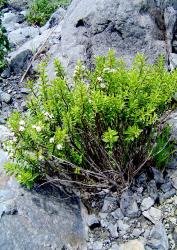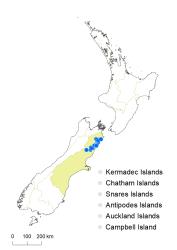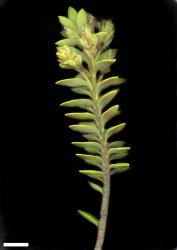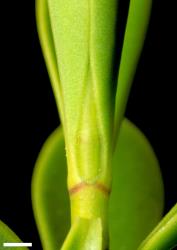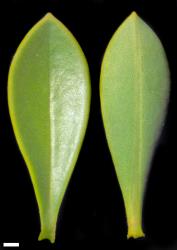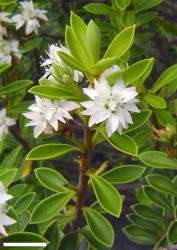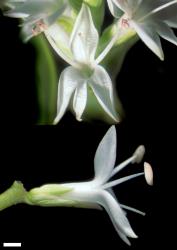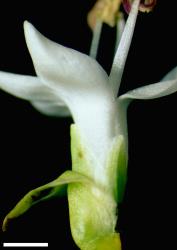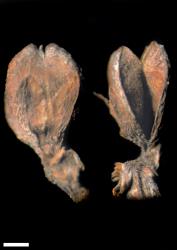- ≡ Hebe rupicola (Cheeseman) Cockayne & Allan, Trans. New Zealand Inst. 57: 26 (1926)
- = Hebe lapidosa G.Simpson & J.S.Thomson, Trans. Roy. Soc. New Zealand 70: 31 (1940)
Bushy shrub, usually to 0.8 m tall, sometimes to 1.5 m. Stems decumbent to erect, eglandular-pubescent; hairs bifarious. Leaf bud distinct, its leaves appressed at margins until fully grown; sinus acute. Leaves opposite-decussate, erecto-patent to spreading; lamina coriaceous, elliptic to oblanceolate, 4–24 mm long, 2–9 mm wide, dull or slightly glossy pale to yellowish-green above, dull and glaucescent to glaucous beneath; midrib evident; surfaces glabrous or eglandular hairs along midrib above; margin usually minutely papillate, sometimes eglandular- or glandular-ciliate, entire; apex acute to obtuse or shortly plicate-acuminate; base cuneate; petiole 1–5 mm long. Inflorescence a lateral spike, simple or tripartite, 13–47 mm long; flowers crowded, 5–37; peduncle 3–20 mm long, female or bisexual on separate plants, ⚥ ≥ ♀; bracts opposite-decussate, sometimes shortly connate, lanceolate to ovate, overtopping and obscuring calyx; pedicels absent or erecto-patent, 0–1 mm long, sparsely eglandular-hairy all around. Calyx lobes 4, free or anterior united up to ⅔-way, obtuse to acute, 3–4 mm long, sub-equal, mixed glandular- to eglandular-ciliolate to -ciliate. Corolla 6–9 mm diameter; tube white, 3.0–4.9 mm long, ≥ calyx, glabrous; lobes 4, white, spreading to recurved, unequal, lanceolate to ovate, 2.5–5.0 mm long, sub-acute to acuminate; nectar guides absent. Stamen filaments white, 3.3–4.2 mm long; anthers white, buff, pink, or purplish. Style glabrous, 5.5–8.3 mm long. Capsules latiseptate, obtuse, glabrous, 4–5 mm long, 2.3–3.2 mm at widest point. Seeds ovoid to oblong, flattened, smooth, straw-yellow to pale brown, 1.4–2.2 mm long.
Veronica rupicola is distinctive. Plants can be recognised by the opposite-decussate sessile flowers with large bracts that overtop and obscure the calyx; acute to acuminate corolla lobes; large capsules, large seeds, and the leaves being pale or yellowish-green above and duller and glaucescent to glaucous beneath. Their pale leaves and petioles contrast with the darker brown or brownish stem. The narrow and acute to acuminate corolla lobes are similar to those of V. colensoi, but plants of that species are distinguished by their very glaucous leaves, which are sometimes shallowly toothed, shorter corolla tube, smaller capsules and fruits, and glabrous bracts and calyx.
V. rupicola plants are sometimes confused with V. rigidula, which is also characterised by a narrow, acute sinus, sessile flowers, long corolla tube, and pale anthers, and also grows in Marlborough, but north of the Wairau River. V. rigidula plants can be distinguished by their smaller bracts and calyces, more rounded corolla lobes, smaller capsules and seeds, and usually more strongly glaucous leaves.
South Island: Marlborough, North Canterbury (Awatere Valley, Chalk Range, Kaikōura Ranges and coastal hills, south to Mason River).
Rock outcrops, cliffs, sometimes in river bed shingle. Recorded elevations range from 198 to 1159 m.
Flowers: December–March; fruits: January–May (persisting to October).
2n = 40 (see Bayly & Kellow 2006, as Hebe rupicola).
Veronica rupicola is classified in V. subg. Pseudoveronica sect. Hebe and the informal group “Apertae” (small-leaved) (Albach & Meudt 2010; Bayly & Kellow 2006).



